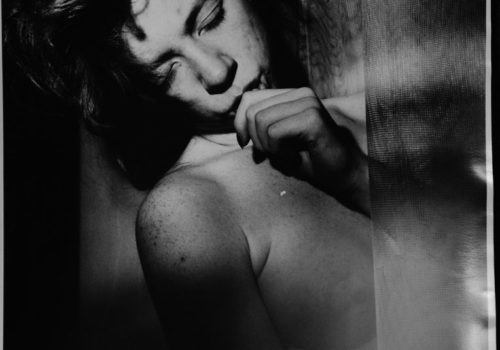After March 11, Tokyo Photo 2011 lay perilously close to being swallowed by the severe financial after effects of Japan’s triple disaster. Despite a successful launch in 2009, growing domestic and international interest, and 10,000 visitors in 2010, the photo fair was struggling to find sponsors. “Just as we were debating whether or not to cancel, Tate Modern approached us and said we really should go ahead with the fair,” says cofounder Takeshi Thornton. “They said it would be a good thing for the market here and it would show how other countries in the world do care about what’s happening in Japan.” Then in June the French Embassy in Tokyo also offered support. “They had this wonderful idea about doing a charity exhibition. Japanese galleries were also encouraging us. We then felt we had enough momentum to go ahead despite the extraordinary circumstances,” says Thornton.
The photo fair reemerged for the third time from September 23-25 at the Tokyo Midtown Hall in Roppongi. About 20 leading galleries from Tokyo, New York, San Francisco, London and Amsterdam were represented. Also on view were several intriguing exhibitions. Works by Chris Shaw, titled Before and After the Night Porter was a specially commissioned show curated by Tate Modern’s Simon Baker. Included were images from his award-winning series Life as a Night Porter. These were shot over a ten-year period while Shaw, a struggling art student/artist, was working as a night-shift porter in London hotels. Edged with humor and sympathy, the works peel back the gritty underside of nocturnal life in B-grade hotels. Shaw says it was Japanese photo greats such as Ikko Narahara and Daido Moriyama who inspired him to become a photographer. The Englishman’s visit to Japan during the photo fair was his first – surely a visual homecoming. A charity exhibition and art sale entitled, France-Japon: ensemble pour demain, led by French Embassy Cultural Attache, Helene Kelmachter, was also on display. Works by eight photographers were chosen, four French and four Japanese, to document the post-disaster areas.
Sales were split 50/50 between the photographers and selected charities working in the devastated Tohoku region. These organizations include a fund for orphans organized by architect Tadao Ando; the Cube Cube project established by photographer Keiichi Tahara, designing and building homes for displaced residents; Life 3.1.1 a long-term project setup by musician Ryuichi Sakamoto to build wooden homes in hard-hit Iwate prefecture; Rebirth Project created by actor Yusuke Iseya. “Rather than supporting institutions or museums we wanted to support humanitarian projects that are run by those in the cultural fields,” explains Kelmachter. “This is a way for culture to support the many in Tohoku who are still in need.”
Works by veteran Japanese photographer Kishin Shinoyama titled Atokata that were taken during his trips to the region was also be on display. Sales went also to charities serving the areas. “I’ve never taken photos like this before,” said Shinoyama during the fair’s press conference. “At first I didn’t know what to photograph, it was so overwhelming. I’m not a photojournalist, and usually want to express my personal feelings in my work. What I felt was sadness but I also found a kind of beauty.” The series is a mixture of stark portraits of local residents and quiet vignettes of nature, post-apocalypse. “When I visited the hard-hit areas, it was so calm. It seemed impossible that the ocean could become so terrifying and destructive.”
A show from Ricoh’s photo gallery Ring Cube, displayed at New York Photo Festival 2011, was on view, as well as a series sponsored by Bulgari with 20% of sales going to Save the Children. It was a visit to Paris Photo 2008 that inspired cofounder Tomohiro Harada to establish Tokyo Photo in 2009. “Most of the top contemporary art galleries in Japan do 70 percent of their business overseas,” explains Harada. “There’s not much of an art market here and if you limit it to photography the number of buyers is so small. But I saw this as an opportunity.”
During last year’s fair, sales results varied widely. Emon Photo Gallery, based in Tokyo, attracted strong sales with a series of city montages titled “Diorama Map” by Japanese photographer Sohei Nishino. Yossi Milo Gallery, arguably New York’s finest photo gallery, brought in disappointing sales until the last day. “The work he was offering was amazing high quality but priced a little too high for new collectors who are the bulk of the fair’s visitors,” says Thornton.
“But my brother, who has never bought photography before, ended up purchasing a Sze Tsung Leong landscape for about US$6000. ”
Without a strong photo collector’s base, the fair attracted students and new, young collectors. “Photography is reasonably priced compared to other art forms, so it’s easier for younger people to purchase,” explains Thornton. “But the galleries have asked us to begin targeting higher-level collectors which we’ve now started to do.
Our goal this year is 20,000 visitors.”
For many art and photography fairs, a total sales figure was hard to calculate. Most purchases occur one to two months after the fair is over when collectors have had time to really consider the work and consult with the gallery. “We’ve often been asked to come up with a total sales number,” says Thornton. “So this year we’ll be doing a follow-up with the galleries several months after the fair. This will give us a better idea of Tokyo Photo’s potential.”
Lucy Birmingham
















